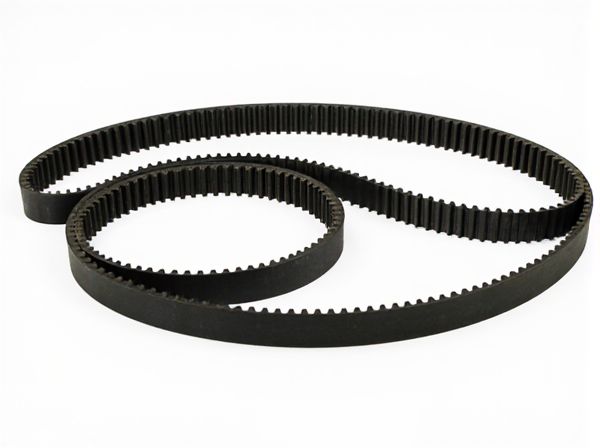
Photo illustration: Single-Sided Tooth vs Double-Sided Tooth Timing Belt
Single-sided tooth timing belts feature teeth on only one side, providing precise engine timing and reduced noise, making them ideal for most standard automotive applications. Double-sided tooth timing belts have teeth on both sides, allowing them to drive multiple pulleys simultaneously and accommodate more complex engine designs or machinery requirements. Ensure your equipment specifications match the belt type to optimize performance and durability.
Table of Comparison
| Feature | Single-Sided Tooth Timing Belt | Double-Sided Tooth Timing Belt |
|---|---|---|
| Tooth Design | Teeth on one side only | Teeth on both sides |
| Application | Standard engine timing; common in automotive engines | Complex drive systems; used in reverse or dual drives |
| Load Capacity | Moderate load handling | Higher load capacity due to dual contact |
| Durability | Standard durability under typical conditions | Enhanced durability; better wear resistance |
| Cost | Generally lower cost | Higher cost due to complex design |
| Installation | Easier installation and maintenance | Requires precise alignment and skill |
Introduction to Timing Belts
Timing belts with single-sided teeth engage only on one side of the belt, providing precise synchronization for applications requiring minimal noise and smooth operation, commonly used in automotive engines and industrial machinery. Double-sided tooth timing belts feature teeth on both sides, enabling power transmission from both sides of the belt, ideal for complex systems that require flexibility and dual-drive capabilities. Selecting the appropriate timing belt type depends on factors like load capacity, environmental conditions, and the specific mechanical requirements of the machinery.
What is a Single-Sided Tooth Timing Belt?
A single-sided tooth timing belt features teeth on only one side, designed to engage with the pulley's grooves for precise power transmission and timing accuracy in machinery. This type of belt is commonly used in automotive engines, 3D printers, and conveyor systems where efficient and quiet operation is critical. Its design offers easier installation and maintenance compared to double-sided tooth belts, which have teeth on both sides for complex routing needs.
What is a Double-Sided Tooth Timing Belt?
A double-sided tooth timing belt features teeth on both the upper and lower surfaces, allowing it to engage pulleys on either side simultaneously. This design is crucial for applications requiring synchronic motion in opposite directions or compact mechanical layouts where space optimization is essential. Double-sided belts enhance torque transmission and maintain precise timing in advanced machinery such as dual-shaft drives and conveyor systems.
Key Differences: Single-Sided vs Double-Sided Timing Belts
Single-sided timing belts feature teeth on only one side, enabling them to engage with pulleys in conventional power transmission systems, while double-sided timing belts have teeth on both sides, allowing for simultaneous power transfer from both sides in more complex machinery. Single-sided belts are typically used for simple mechanical setups requiring straightforward torque transmission, whereas double-sided belts accommodate bidirectional driving and higher load capacity due to the engagement of teeth on two sides. The choice between single-sided and double-sided timing belts depends on application requirements such as flexibility, load distribution, and space constraints in industrial automation or automotive timing systems.
Advantages of Single-Sided Tooth Timing Belts
Single-sided tooth timing belts offer advantages such as smoother operation and easier installation due to the exposed tooth side, allowing for visual wear inspection and alignment. These belts typically provide reduced noise and vibration compared to double-sided tooth timing belts, enhancing overall system efficiency. Their design facilitates simpler maintenance and replacement, making them ideal for applications requiring high precision and reliability.
Benefits of Double-Sided Tooth Timing Belts
Double-sided tooth timing belts offer enhanced load distribution and increased torque capacity, making them ideal for high-power applications. Their design allows for greater flexibility in complex pulley arrangements and improved alignment, reducing the risk of slippage and extending belt lifespan. These belts provide better power transmission efficiency and smoother operation compared to single-sided tooth timing belts.
Common Applications for Each Timing Belt Type
Single-sided tooth timing belts are predominantly used in applications requiring precise timing and moderate load transmission, such as 3D printers, office automation devices, and light-duty conveyors. Double-sided tooth timing belts excel in complex mechanical systems like automotive engines, industrial machinery, and printers, where synchronization of multiple shafts on both sides improves power transmission and reduces slippage. Each type's unique tooth design optimizes performance based on load demands and spatial constraints in their respective industries.
Selection Criteria: Choosing the Right Timing Belt
Selecting the right timing belt requires evaluating load capacity, belt flexibility, and application environment, where single-sided tooth belts excel in lower load, high-speed operations due to their lighter design and easier maintenance. Double-sided tooth timing belts provide enhanced power transmission and bidirectional flexibility, making them ideal for complex machinery requiring reverse motion or increased strength. Material durability and tooth alignment also influence selection, with double-sided belts typically offering superior grip and resistance in heavy-duty applications.
Maintenance and Durability Considerations
Single-sided tooth timing belts require regular inspection for wear and alignment since their exposed teeth are more prone to damage and contamination, affecting durability. Double-sided tooth belts offer enhanced longevity due to teeth engagement on both sides, reducing slippage and distributing load evenly, which lowers maintenance frequency. Choosing between single-sided and double-sided timing belts depends on the application's load demands and maintenance accessibility, with double-sided belts typically providing superior durability in high-stress environments.
Conclusion: Which Timing Belt is Best for Your Needs?
Single-sided tooth timing belts are ideal for applications requiring precise positioning and quieter operation, typically in low to moderate load environments. Double-sided tooth timing belts offer enhanced durability and the ability to handle higher torque loads, making them suitable for industrial machinery and heavy-duty use. Choosing the best timing belt depends on your specific requirements regarding load capacity, noise levels, and design constraints.
 caratoz.com
caratoz.com